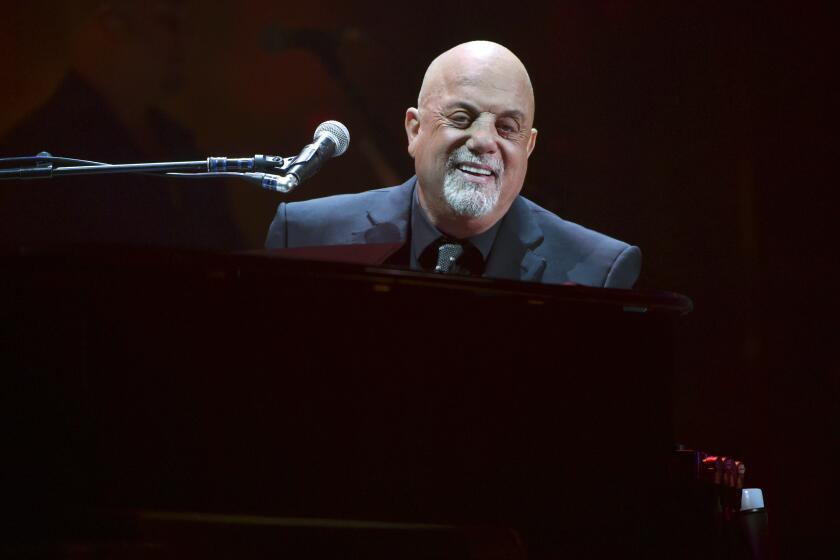Say it loud: He gave music some new moves
FOR all the impact of such towering figures as Ray Charles, Sam Cooke and Marvin Gaye, no one influenced black music more than James Brown because no one mirrored black culture more than the man behind such hits as “Please, Please, Please,” “Papa’s Got a Brand New Bag” and “I Got You (I Feel Good).”
You hear his percolating style in Prince’s funky guitar licks, see his spectacular physicality in Michael Jackson’s dance steps and feel his spirit and self-affirmation in every explosive hip-hop record.
Long before he was showered with celebrated (and eminently fitting) titles such as “the Godfather of Soul” and “the Hardest-Working Man in Show Business,” Brown was briefly thought of by some as the black Elvis, which was mostly silly -- except in one profound way.
If Presley was the artist most often cited by leading white musicians as an influence -- and I found that to be true in the ‘60s and ‘70s -- Brown was the name I most often heard when asking African American musicians about who inspired them.
Brown’s influence isn’t limited to black artists by any means. One of the most illuminating pop moments ever captured by a camera was when a young Mick Jagger stood in the wings, mesmerized, watching Brown’s seductive moves during the ‘60s concert film “The T.A.M.I. Show,” and we all know how Jagger eventually built his stage performance around those moves.
If anything, Brown’s impact on modern pop music is underrated, partly because he did most of his defining work on secondary record labels that didn’t have massive publicity machines and he never really embraced the mainstream the way, say, Ray Charles did. Yet, you could build a case that Brown was also the “Godfather of Disco,” the “Godfather of Rap” and the “Godfather of Funk” because his electrifying beats powered so many genres.
Like Presley, the Southern-bred musician touched a sociological nerve that went far beyond normal pop stardom.
Though the lyrics of Brown’s hits were often little more than catchy phrases, the best lines were right in step with the rise of black pride in this country, and they are why he was such a powerful, beloved figure during the civil rights era.
“Say It Loud -- I’m Black and I’m Proud,” he screamed on a record, released only five months after the assassination of the Rev. Martin Luther King Jr., that channeled the righteousness of an oppressed people into a three-minute declaration of independence that topped the R&B; charts for weeks.
Though millions of pop and rock fans also thrilled to Brown’s music in the ‘60s and ‘70s, he wasn’t embraced by mainstream radio nearly as strongly as by R&B; stations, which is why he had 60 top 10 R&B; hits (more than any other artist) but fewer than a dozen top 10 pop hits (which wasn’t enough to place him in the top 25 among artists).
Given the immense appeal of his records and style, it’s hard now to understand his relatively limited chart success, but the noteworthy thing about Brown’s music is it is so enduring. By the mid-’80s, other artists, especially the Beatles and Bob Dylan, were cited by white musicians as their chief inspiration, but Brown remained the influence most mentioned by black musicians (along with a sizable number of white musicians).
Lots of early R&B; stars made records with an eye toward the pop mainstream, especially the lucrative teenage market, but Brown, in the tradition of bluesman John Lee Hooker, never tempered his blues-R&B-gospel; merger, and his themes were mostly adult: “Get Up (I Feel Like Being A) Sex Machine,” “It’s a Man’s Man’s Man’s World” and “Cold Sweat.”
Brown didn’t sing as much as he growled, as if he were trying to match the intensity that grew out of his essential funk brew, powered by guitars, horns, bass and drums.
He wasn’t an easy interview; he didn’t seem interested in talking about himself (his background was troubled, and he had more than his share of court appearances) or his music. Thus, he ended up telling the same stories over and over.
Part of the problem was that Brown found it frustrating to try to explain his true passion -- the elements of his music -- just as a great painter finds it difficult to tell us why he sees things in a certain way. Writers too had a hard time capturing in words the magic of Brown’s instrumental sound.
In the end, Brown seemed comfortable only in the studio and, especially, on stage. At his prime, he moved with such speed and grace that it took your breath away. Even listening to his superb live albums -- starting with 1962’s “Live at the Apollo” -- you feel the heat of his scorching performance.
The easiest way to explain Brown’s genius to someone is simply to play one of his best records.
In nominating the 500 greatest singles ever in a 1989 book, rock critic Dave Marsh listed “Papa’s Got a Brand New Bag” at No. 3, declaring that the only way the single could be “more bone-rattling was if Brown himself leaped from your speakers, grabbed you tight by the shoulders and danced you around the room, all the while screaming straight into your face.” He added, “No record before ‘Papa’s’ sounded anything like it. No record since -- certainly no dance record -- has been unmarked by it.”
Still, my favorite James Brown record is probably “I Got You (I Feel Good),” which was the follow-up to “Papa’s Got a Brand New Bag.” It was a record of supreme optimism and cheer. I’ve even got a foot-high James Brown bobblehead in my den, and it screams “I Feel Good” when you push a button.
I’ve pushed it dozens of times when friends were over, and every time it brought smiles. It’s just one sign that Brown’s music remains powerful. For another sign, just turn on the radio. Half the music you hear, from Kanye West and Jay Z to Justin Timberlake and the Red Hot Chili Peppers, is in part a testimony to that power.
At some point today, I’ll just push the button on the bobblehead doll, or put on one of Brown’s CDs. There’s no way that music won’t still make you feel alive. What a wonderful legacy for any artist.
Robert Hilburn, who was The Times’ pop music critic for nearly 40 years, left the paper in January to write a cultural history of pop music.
More to Read
The biggest entertainment stories
Get our big stories about Hollywood, film, television, music, arts, culture and more right in your inbox as soon as they publish.
You may occasionally receive promotional content from the Los Angeles Times.






